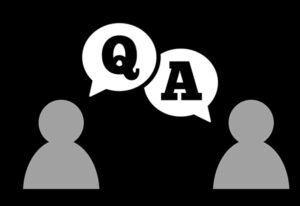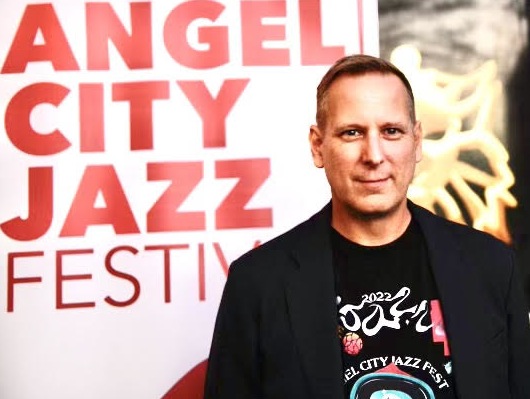
THE Q&A: Festival promoter says jazz is part of L.A.’s cultural fabric
By Darlene Donloe
Contributing Writer
LOS ANGELES — For 10 years Rocco Somazzi worked the Los Angeles jazz scene booking and promoting music acts at various venues.
Somazzi, the founder and director of Angels City Arts, the nonprofit that produces the Angel City Jazz Festival, worked his magic at venues that included the Lillian Theatre in Hollywood, the Cafe Metropol in downtown Los Angeles and Royal/T in Culver City.
A music promoter, Somazzi opened a restaurant and jazz club in Bel Air called Rocco, which he sold in 2001 to music icon Herb Alpert, who renamed it Vibrato Grill Jazz.
Promoting and presenting individual jazz artists proved to be challenging.
“I thought to myself, it’s hard to promote jazz artists who are lesser known and more cutting edge,” said Somazzi, a native of the Italian part of Switzerland. “So, I thought maybe if I present them in a setting more like a festival, I can generate more awareness. I can market the shows better.”
So in 2008, Somazzi launched the Angels City Jazz Festival at Barnsdall Art Park featuring 10 bands on two stages.
“We found the music is not easy-listening, so we decided to break it up and program fewer bands spread over more days,” said Somazzi, who is 51 and married. “Now it’s grown to two weeks. We have nine evenings this year. It works best for this kind of music.”
This year, the Angels City Jazz Festival, a multi-day celebration of creative jazz from around the world, plays Oct. 13-29 at various venues around the city including the Los Angeles County Museum of Art, the World Stage, 2220 Arts + Archives, Artshore LA, Zipper Hall at Colburn School, the Moss Theatre, Santa Monica Public Library, Zebulon and REDCAT at Disney Hall.
This year’s lineup includes: Oct. 13 – Sam Rivers 100 with Mark Masters’ Ensemble & Billy Harper; Oct. 14 – Destiny Muhammad Trio with Teodross Avery; Oct. 15 – Crump/Laubrock/Smythe + Jeong Lim Yang’s Zodiac Trio; Oct. 16 – Intergenerational Improvisation Night; Oct. 21 – Root Progressions with Gloria Cheng, Linda May Han Oh & Jon Jang; Oct. 22 – Todd Sickafoose’s BEAR PROOF + Kirk Knuffke Trio; Oct. 25 – Harriet Tubman + OCEANS and Tim Berne, Aurora Nealand and Hank Roberts; Oct. 26 – Nicole Mitchell’s The Mandorla Letters Book Reading; Oct. 27 – Mat Maneri Quartet + Ennis Harris ‘Images & Silhouettes’; Oct. 28 – Nicole Mitchell’s JBM: Images Beyond + Next Jazz Legacy Showcase, and Oct. 29 – Todd Cochran Trio TC3 with Bennie Maupin + Billy Mohler Quartet’s “Ultraviolet” CD Release Party.
Angel City Arts is a nonprofit organization with a stated mission of cultivating and revitalizing jazz culture in Los Angeles.
I recently spoke to Somazzi about the festival and why he thinks jazz is important for the Los Angeles culture.
DD: When and why did you start your foundation?
RS: The Angels City Arts was founded in 2009. I personally financed the first festival in 2008. I soon realized I couldn’t keep doing it without support. So I applied for grants. We also accept donations.
DD: Why should people come to the festival?
RS: The artists we present are some of the best in the world. We ask them to perform with freedom and experimentation. It’s exciting, relevant and fresh music. There are no restrictions. You will see and hear the purest form of expression. It’s music that is not played on the radio or TV. It’s more genuine and more direct. Many of the artists in the festival don’t play often in Los Angeles. We are presenting one-of-a-kind evenings.
DD: What separates the Angel City Jazz Festival from other jazz festivals in Los Angeles?
RS: One of our characteristics is we call it a forward-looking festival. There is a general idea of respecting the 50s and 60s, [the players] who laid the foundation. We are looking for the next interpretation of what jazz is. You won’t hear “jazz greats” repertoires at our festival. We specialize in the new sound of jazz.
What sets us apart is an uncompromising commitment to presenting the highest level of music regardless of commercial success or any other factors.
DD: Regarding the venues: LACMA, The World Stage, 2220 Arts + Archives, Artshore LA, Zipper Hall at Colburn School, the Moss Theatre, Santa Monica Public Library, Zebulon, REDCAT at Disney Hall, why were they chosen?
RS: One of our strengths is forging partnerships in different communities in different kinds of towns. We developed those partnerships over a lot of years.
DD: Do you have a favorite jazz artist?
RS: That’s a difficult question. From the 50s-60s Beebop era, I like all the greats. I like [John] Coltrane and [Dizzy] Gillespie. My absolute favorite is Miles Davis because of his spirit of innovation and his fearlessness.
DD: Who is your favorite jazz artist living today?
RS: I like listening to avant-garde music. I like listening to Henry Threadgill. He’s unbelievable. He’s been very influential. He’s underground. His music is mind-blowing.
DD: What does jazz do for you?
RS: It’s all about the experience of listening to people improvise live. It’s an immediate connection. It’s an experience I can’t describe. I experienced it as a kid at 12-13. We had a free festival called Estival Jazz in Lugano (Switzerland), a small town, every summer for three days in the public square. Estival means summer. When you listen to jazz, you feel someone telling a story to you. It’s an experience I haven’t felt in any other place, in any other way.
DD: At one time jazz was huge, then it wasn’t. What happened to jazz?
RS: It’s not pop music anymore. In the 60s with big band music, it was pop music. Little by little the role has been taken by other kinds of music. Jazz is now its own niche. It’s underground.
DD: Do you like Smooth jazz?
RS: I do not. I’m diametrically opposed to it. We want to push in the other direction. We want jazz to be an intense connection. We want them to be passionate about their feelings. It’s something I might listen to when I’m cooking in the kitchen.
DD: Why is jazz important to the Los Angeles culture?
RS: Most of the music that is popular has roots in jazz. What’s happening in the jazz scene is not a common sound. There is no common denominator. It’s important to support jazz. It’s part of the cultural fabric of the city.
DD: What is the festival’s average attendance?
RS: Well, this year’s festival is nine days, which is a new record. The venues have different capacities. Zipper Hall at Colburn School has a capacity of 500. We are comfortable with smaller environments like 200 per show. We’re not into huge audiences. We want the people who really want to be there to experience the jazz.
DD: Some of the concerts are free and others can cost up to $20. Why?
RS: We try to keep prices low. That’s why we apply for grants. Two of the events are free, LACMA on Oct. 13. There will be a 13-piece band. Most other shows are $10-$25 depending on the venue. There is a free reading from Nicole Mitchell on Oct. 26 at the Santa Monica Public Library. She will play on Oct. 28. We have discounts for students and seniors. I’m not a big fan of doing too many free shows. There’s a lot of work that goes into the shows.
DD: Who is hosting all of the events?
RS: The official host is Leroy Downs of KCRW. He’ll be at LACMA. I’ll be doing the introductions at all of the other venues. Just like the fans, I’m looking forward to hearing some good music.
“The Q&A” is a feature of Wave Newspapers asking provocative or engaging questions of some of L.A.’s most engaging newsmakers or celebrities.
Darlene Donloe is a freelance reporter for Wave Newspapers who covers South Los Angeles. She can be reached at ddonloe@gmail.com.













